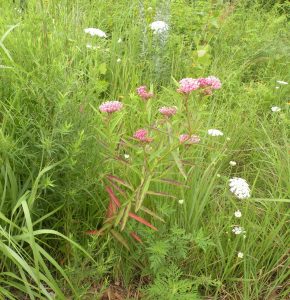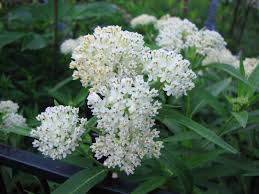
Asclepias incarnata with pods, Daucus (Qeueen anne’s Lace) in a meadow
Most of the discussion over the past few years about planting milkweed to help migrating Monarch butterflies has centered on Asclepias tuberosa (Butterfly Weed) but there are several other milkweeds that are just as useful. However, their habitat is different. While Asclepias tuberosa prefers sunny, average to dry sites, many of the other species prefer moister environments. And we have plenty of those this year!

Asclepias incarnata closeup
Asclepias incarnata (Swamp Milkweed), hardy in zones 3-7, has narrow, lance-shaped foliage and lovely rose-pink umbels in June and July on three to five-foot stems, thus, is taller than Asclepias tuberosa, so is better used as a background plant. This American native, like Asclepias tuberosa, has a deep taproot and is late to emerge in the spring. Many types of butterflies and bees as well as hummingbirds and hummingbird moths are attracted to the faintly vanilla scented flowers as a nectar source. Monarch butterflies, in their larval (caterpillar) stage, use this milkweed as a food source.
The flowers are followed by attractive, long seed pods that split open when ripe, releasing silky-haired seeds easily carried by the wind. If you do not want to be overwhelmed with seedlings, it is best to prune off the pods, leaving only a few.
The stems are full of milky sap so wear gloves when cutting it back in late fall or early spring. As the common name implies, this Asclepias performs best in moist soil but will also do well in soil that receives average moisture and is well-drained.

Asclepias incarnata ‘Ice Ballet’-plantmorenatives.com
I see no difference between the cultivar ‘Cinderella’ and the species. There is also a white cultivar named ‘Ice Ballet’. As a native of wet meadows and prairies, Asclepias incarnata combines well with other natives such as Eupatorium fistulosum (Joe Pye Weed) and Aster novae-angliae (New England Aster) and is a useful plant in rain gardens.
If you are looking for a perennial that attracts pollinators and is deer-resistant, look no further than Asclepias incarnata.


0 Comments